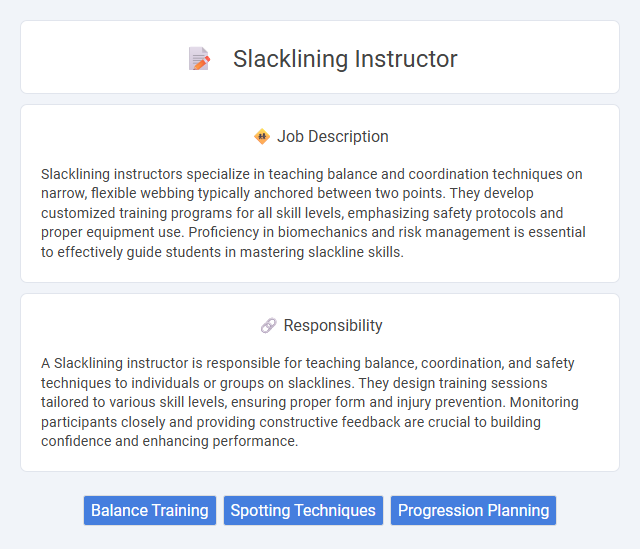
Slacklining instructors specialize in teaching balance and coordination techniques on narrow, flexible webbing typically anchored between two points. They develop customized training programs for all skill levels, emphasizing safety protocols and proper equipment use. Proficiency in biomechanics and risk management is essential to effectively guide students in mastering slackline skills.
Individuals with strong balance, coordination, and a passion for outdoor activities are likely to excel as Slacklining instructors. Those comfortable with physical activity and patient in teaching beginners could find this role highly suitable. Conversely, people with limited physical agility or discomfort working in outdoor environments might find the job challenging.
Qualification
A Slacklining instructor must possess comprehensive knowledge of balance techniques, safety protocols, and equipment setup to effectively guide beginners and advanced practitioners. Certification in outdoor recreation or fitness instruction, along with first aid and CPR training, is highly recommended to ensure participant safety and professional credibility. Practical experience in slacklining and strong communication skills are essential for delivering clear, engaging, and adaptable lessons.
Responsibility
A Slacklining instructor is responsible for teaching balance, coordination, and safety techniques to individuals or groups on slacklines. They design training sessions tailored to various skill levels, ensuring proper form and injury prevention. Monitoring participants closely and providing constructive feedback are crucial to building confidence and enhancing performance.
Benefit
Working as a Slacklining instructor likely offers significant health benefits, including improved balance, coordination, and core strength. The job probably fosters a strong sense of community and teamwork among participants, enhancing social skills. Instructors may also experience personal fulfillment from helping others develop confidence and resilience through physical activity.
Challenge
Mastering slacklining requires constant balance and focus, presenting a challenge that many find both exciting and demanding. A slacklining instructor likely faces the task of guiding students through overcoming fear and building confidence on the line. The role probably involves adapting teaching methods to suit varied skill levels while ensuring safety and progression.
Career Advancement
A Slacklining instructor role offers extensive opportunities for career advancement through certifications in advanced teaching techniques, safety protocols, and event coordination. Gaining expertise in diverse slackline styles, such as tricklining and highlining, enhances marketability and opens doors to leading workshops or managing slackline parks. Developing strong client relationships and building a professional network within outdoor recreation and adventure sports industries can further propel career growth.
Key Terms
Balance Training
A Slacklining instructor specializes in balance training by guiding students through exercises designed to improve core stability, coordination, and focus on a narrow, flexible line anchored between two points. This role requires expertise in biomechanics and progressive skill development techniques to enhance proprioception and body control. Effective instruction promotes injury prevention and confidence, making it essential in fitness programs aimed at agility and mental concentration.
Spotting Techniques
Mastering spotting techniques is essential for a Slacklining instructor to ensure participant safety and build confidence on the line. Instructors employ strategic positioning, clear communication, and hands-on support to prevent falls and guide learners through challenging maneuvers. Expertise in spotting enhances teaching effectiveness and reduces injury risks during slackline training sessions.
Progression Planning
A Slacklining instructor specializes in designing structured progression plans that enhance skill development from beginner to advanced levels. Effective progression planning integrates balance training, core strengthening, and dynamic movement techniques tailored to individual student goals. Clear milestones and adaptive challenges ensure continuous improvement and injury prevention in slacklining practice.
 kuljobs.com
kuljobs.com